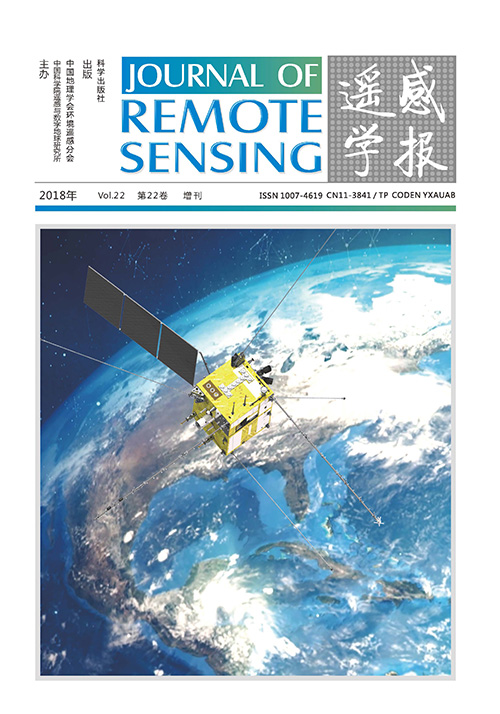|
收稿日期: 2017-06-16
基金项目: 高分辨率对地观测系统重大专项应用示范一期(编号:31-Y30B09-9001-13/15)
第一作者简介: 马未宇,1971年生,男,副研究员,研究方向为地震遥感应用。E-mail:weiyuma@163.com
通信作者简介: 康春丽,1964年生,女,研究员,研究方向为地震遥感。E-mail:kangchli@seis.ac.cn
中图分类号: P315
文献标识码: A
|
摘要
研究引潮力的相位变化周期与发震的关系,进而确定地震大气温度增强异常识别的背景指示时间,采用大气分层技术,处理美国国家环境中心的NCEP大气温度数据,分析了昆仑山MS8.1地震前后不同高度层的大气温度垂直分布动态演化,结果显示:地震发生时引潮力值所处最大振幅相位附近,反映引潮力对本次地震的发生具有触、诱发的作用;孕震区地表及其上附多层大气热变化经历震前起始增温,震后消亡的连续时间演变过程,增温区集中在地震活动断裂带及其附近区域,呈现出与构造紧密关联的非均匀加热,与岩石受力,由形变—破裂过程中向外热辐射变化过程相吻合,表明大气增温与昆仑山地震活动相关;热增强表现出自下而上的从地表开始增温,并随大气运动抬升扩散,在一定高度的高空逐渐消亡的过程,符合地面对大气加热导致大气升温、抬升、扩散、消亡的大气热动力学特性,表明下垫面构造运动是本次温度异常变化的主控原因;大气增温过程与引潮力(低值—高值)的变化过程具有一定的同步性,显示引潮力为地震大气温度异常识别过程中,背景温度选择提供具有力学含义、可预先计算获得的时间指示,而通过引潮力周期获得的大气温度变化反映了临震构造应力的变化,将引潮力变化与大气温度垂直分层分析结合,将有助于区分地震热异常与非震热异常。
关键词
地震遥感, 温度异常, 垂直分布, 天体引潮力, 构造断裂
Abstract
The paper analyzed the relationship between an earthquake and a celestial tide-generating force. We selected the background that indicates the time for the research of the abnormal enhancement in identifying the atmospheric temperature rise caused by an earthquake based on the phase change cycle of tidal force. Then, with the use of atmospheric stratification, which is integrated with atmospheric temperature data from the National Center for Environmental Prediction, the air temperature evolution of several different levels in the vertical direction before and after the MS8.1 Kunlun Mountains earthquake was analyzed. Results show that the earthquake occurred when the tidal force value was near the maximum amplitude phase. Thus, the tidal force could trigger an earthquake near land surfaces and upper multi-layers. The warming areas are mainly concentrated near active faults, thereby exhibiting non-uniform heating procession. The temperature increased to a continuous evolution procession of warming before the earthquake and recession after the earthquake. It obeyed the rule of thermal rise procession of rock broken under stress loading. Thus, the increase in temperature was related to the activities of the regional fault. Meantime, the air temperature performed a warm procession, that is, the surface air is warmed by land, uplifted by heat flux, and cooled and dissipated in the sky. It is consistent with the dynamic diffusion principle of atmospheric air thermal warming by land in the vertical direction. The tectonic activity is the main cause of the abnormal change in temperature. Finally, the atmospheric warming process stepped with the tidal force (from low phase to high phase) change process. Therefore, the tide force not only delivered a mechanical basis and calculated the time to select the background in advance in research on air temperature warming during an earthquake but also showed that the atmosphere temperature change, according to the tidal force change cycle, could reflect the change in tectonic stress prior to an impending earthquake. Combining the analysis of the tidal force change and the analysis of atmospheric vertical temperature stratification distinguishes the increase in air temperature anomalies caused by the earthquake from that which is not caused by an earthquake.
Key words
earthquake remote sensing, temperature anomaly, vertical distribution, celestial tide-generating stress, tectonic fault
1 引 言
利用地震前地球表面温度异常动态变化预测地震备受关注(Mogi,1984),震前地球表面温度异常动态变化研究结果表明:震前热异常与地震存在关联(Tronin,2002;Saraf 等,2008;Tramutoli 等,2001;Ouzounov和Freund,2004)。前苏联学者Gorny等人(1988)发现震前出现大面积卫星热红外(10.5—12.5 μm)异常波动,开辟了利用热遥感技术大范围、快速、准实时获取地震信息的新途径。RTS(Robust Satellite Technique)技术被引入该研究领域中(Tramutoli,2007;Lisi 等,2010)。由于该方法采用统计算法,需要多年的统计数据,因此在观测不连续地区的地震中无法开展。Yang和Guo(2010)采用了一种新的相减方法,它利用今天的18:00 (世界时)温度减去昨天的18:00 (世界时)温度,依此类推,获得不同时间序列下一系列的温度变化图像,由于气温变化是非常复杂的,不同背景温度的选择所获得结果差异也很大。Zhang等人(2010)利用卫星遥感热辐射数据通过小波变换方法获得亮温数据,但是选择不同的标准函数傅里叶分裂窗会造成结果的差异。另外,由于热红外不能穿透云层,导致有云区域无法准确获得云下温度,研究中为了获得热异常特征,都尝试剔除有云天数据来解决问题。但云是大气水分相态变化的产物,包含大量的热能交换,去云运算可能造成数据观测人为干扰影响。上述研究集中在分析震前在水平范围内的热异常变化,而大气温度在空间垂直高度上的分布是不均匀的,研究表明将复杂的下垫面环境区分识别将对地震热异常识别具有重要意义(Qin 等,2012, 2013)。由构造运动引起的地震热异常,其热力来源是下垫面构造运动引起的热量交换,热动态演化应呈现出与构造紧密关联的非均匀加热,以及自下而上、从地表开始增温,并随大气运动抬升扩散,在一定高度的高空逐渐消亡的过程。
此外,地震是地球内部构造应力的一种表现,尽管其主要受内部构造应力决定,但地球不是一个孤立的天体,它的运动必然受到宏观天体运动的影响,天体潮汐引力就是主要的外部因素之一(McNutt和Beavan,1981;Heaton,1975),其在地震热变化中的角色值得关注。
2001年11月14日在昆仑山口西青海和新疆交界处发生了Ms8.1级地震。昆仑山西口地震主破裂带主要位于东昆仑断裂南麓冲洪积台地后缘的地貌陡变带和断层谷地内,对青藏高原成因、演化和现今活动性的认识具有独特的地位(单新建 等,2005;任金卫和王敏,2005)。本文利用天体引潮力变化模型计算此次地震的引潮力,探讨引力与地震的关系,并依据引力变化周期为时间背景指导,利用NCEP温度数据,研究2001年中国昆仑山Ms8.1地震热异常时空演变特征。
2 昆仑山地震区域引潮力变化分析
引潮力是周期性连续变化的,其触诱发地震多发生在周期振幅相位最大值的临近时刻(Ma等,2012)。引潮力计算过程如下:
根据卡尔文的计算方法,任意天体对地球内部任意一点P产生的引潮力位
| ${W_i}(P) = k\frac{M}{{{r_{\rm{m}}}}}\sum\limits_{n = 2}^\infty {{{\left({\frac{r}{{{r_{\rm{m}}}}}} \right)}^n}{P_n}} \left({\cos {Z_{\rm{m}}}} \right)$ | (1) |
式中,
对于月亮在目前精度条件取
| $\begin{array}{c}{W_{{\rm{m}}2}}(P) = \displaystyle\frac{3}{4}k\frac{{{M_{\rm{m}}}}}{{{r_{\rm{m}}}}}{(\frac{r}{{{r_{\rm{m}}}}})^2}\\\left\{ \begin{gathered} (1 - 3{\sin ^2}\varphi)(\frac{1}{3} - {\sin ^2}{\delta _{\rm{m}}}) + \sin 2\varphi \cdot \\ \sin 2{\delta _{\rm{m}}}\cos {H_{\rm{m}}} + {\cos ^2}\varphi {\cos ^2}{\delta _{\rm{m}}}\cos 2{H_{\rm{m}}} \\ \end{gathered} \right\}\end{array}$ | (2) |
| $\begin{array}{c}{W_{{\rm{m}}3}}(P) = \displaystyle\frac{3}{4}k\frac{M}{{{r_{\rm{m}}}}}{(\frac{r}{{{r_{\rm{m}}}}})^3}\\\left\{ \begin{gathered} \frac{1}{3}(3 - 5{\sin ^2}\varphi)\sin {\delta _{\rm{m}}}(3 - 5{\sin ^2}{\delta _{\rm{m}}}) + \\ \frac{1}{2}\cos \varphi (1 - 5{\sin ^2}\varphi)\cos {\delta _{\rm{m}}}(1 - 5{\sin ^2}{\delta _{\rm{m}}})\cos {H_{\rm{m}}} + \\ 5\sin \varphi {\cos ^2}\varphi \cos 2{H_{\rm{m}}} \\ \end{gathered} \right\}\end{array}$ | (3) |
同理对于太阳取
| $\begin{array}{c}{W_{{\rm{S}}2}}(P) = \displaystyle\frac{3}{4}k\frac{{{M_{\rm{S}}}}}{{{r_{\rm{S}}}}}{(\frac{r}{{{r_{\rm{S}}}}})^2}\\\left\{ \begin{gathered} (1 - 3{\sin ^2}\varphi)(\frac{1}{3} - {\sin ^2}{\delta _{\rm{S}}}) + \\ \sin 2\varphi \sin 2{\delta _{\rm{S}}}\cos {H_{\rm{S}}} + {\cos ^2}\varphi {\cos ^2}{\delta _{\rm{S}}}\cos 2{H_{\rm{S}}} \\ \end{gathered} \right\}\end{array}$ | (4) |
对于地球整体则有:
| ${W_{{\rm{whole}}}}(P) = {W_{{\rm{m}}2}}(P) + {W_{{\rm{m}}3}}(P) + {W_{{\rm{S}}2}}(P)$ | (5) |
式中,
利用以上公式,计算昆仑山Ms8.1地震前后天体引潮力随时间变化曲线(图1)。横坐标为时间序列,纵坐标为天体引潮力,单位为Gal。由图1可以看出,天体引潮力相位变化具有明显的周期性变化,经历低谷、高峰、低谷的循环,地震发生时引潮力值所处最大振幅相位附近。反映引潮力对地应力达到临界点的活动构造发生地震具有触、诱发的作用,但是地应力的强度变化情况如何?为此我们进一步分析潮汐周期背景下的NCEP大气温度变化。
3 昆仑山Ms8.1地震NCEP增温异常时空演变特征
为了减少地形地貌、地物类型和气象等非震因素干扰,获取由构造活动造成的温度增加,需要利用NCEP数据与背景温度相减的方法,获得发震前后该地区异常增温变化图像。同时,为了尽可能降低白天太阳辐射对大气加热的影响,主要采用夜间(世界时18:00)的大气温度数据进行处理。NCEP再分析资料数据是由美国国家环境预测中心和大气研究中心网上准实时发布,包含50年以上数据(Kalnay 等,1996),该资料集是对来自地面、船舶、无线电探空、探空气球、飞机及卫星等的观测资料进行质量控制和同化处理后得到的,空间分辨率为1°×1°,时间间隔为6 h(秦凯 等,2011),能够满足震前热异常时空监测研究。针对昆仑山地震,本文依据天体引力附加构造应力周期(图1),采用2001年11月9日温度值为正常背景值(潮汐值在最低点),将11月10到17日的温度与之逐日相减,获得同时次、相同区域范围内近地表及其上空不同气压层面上的动态增温变化序列图像(图2),作为该次地震序列临震增温异常分析的客观依据。
如图2所示,在此次地震过程中热异常增温主要表现为,一方面,在时间序列上具有持续性,以近地表600 Pa气压层为例,2001年11月10日出现异常增温现象;11月11日在地震中心以南,持续出现异常增温,较背景温度高出7 K;11月12日异常增温面积、增幅明显减小,仅较背景温度高出4 K;11月13日在西南方向再次出现较大范围的增温,增温幅度较小,震中较背景只增加3 K,表明孕震体中变形的范围正在变大;14日增温异常区向震中逐渐迁移,增幅达到7 K以上,并覆盖震中;15日主震发生后,地形完整性被破坏,形成诸多的塌陷区域或裂隙,成为热通道,释放大量热,在NCEP图像上反映出增温面积进一步扩大,16日增温幅度达到最高10 K以上,并伴有大量的余震发生。17日增温快速衰减,逐渐恢复正常。此次地震异常增温演变时序过程为:起始增温(10日)、加强增温(11日)、增温衰减(12日)、再增温(13—14日)、主震、加剧(15日)、余震、增温高峰(16日)、快速衰减(17日)的演变过程。该过程与遥感—岩石力学试验中岩石受力破裂的红外热像变化过程相似(吴立新 等,2004),表明震前热异常可能是强构造运动的一种热表现。
另一方面,在空间分布尺度上呈现出如下规律:(1)温度异常随大气高度变化,越接近地表热异常增温幅度越大,增温区与震中对应关系越明显。随着大气抬升气体扩散,异常区域面积扩大,幅增减小,但仍与地表分布相似,直到逆温层顶部热异常逐渐消失,说明异常热源来自地面;(2)热异常垂直结构与活动构造分布相吻合。表明该区活动断裂块在发生挤压活动,且构造运动是温度异常变化的主控原因。因为如果该热异常是由气象增温引起,那么气温的影响强度在空间上具有大范围性、逐渐过渡性等特点;在时间上则呈现数天或数小时连续变化(屈春燕 等,2006)。然而地震热异常在空间域上受活动构造控制,它主要集中在活动断裂带上。因此,由地震热活动引起的地表温度变化在空间分布上则表现出孤立性、大幅度增温等特点;在时间上,地震热异常的出现具有突发性,即在一定时段内断续突现(刘军 等,2014)。图2所示时空动态演变特征图恰好符合地震热异常表现特点,因此认为该热异常增温现象与地震活动有关。为了检验方法的可信度,增加更长时间周期的数据研究,分析处理了与发震时刻引潮力相位变化相似的震前与震后两个时段的温度图像,结果均未出现与发震时段相似的连续大气增温现象。
另外,本次地震震前11月12日大气温度的衰减与2013年4月20日芦山Ms7.0地震震前4月19日地面红外热异常的衰减表现相似(马未宇 等,2014),这种临震前的衰减可能表征的岩石应力闭锁期,能否为地震的最终到来提供指示,值得探索。
4 结 论
应用大气分层技术,分析昆仑山Ms8.1地震前后大气温度垂直分布动态演化,结果不仅与岩石在应力加载下发生形变—破裂的过程中热释放过程相吻合,而且符合地面对大气加热导致近地表大气升温、抬升、扩散、消亡的大气热动力学基本特性,反映出下垫面构造运动是本次温度异常变化的主控原因,而非区域外部热量输入造成增温。该方法也展示出利用地震前后大气热异常垂直结构和热扩散方式辨识地面热源异常变化,将有助于解决地震遥感热捕捉技术面临的如何识别非地震构造运动“热”的技术难题。
本文研究仍停留在少数的震例分析,该方法对震前热异常识别是否具有普适性,还需开展更广泛研究,在实践中不断检验、修正。
参考文献(References)
-
Gorny V I, Salman A G, Tronin A A and Shilin B V. 1988. Terrestrial Outgoing infrared radiation as an indicator of seismic activity. Proceedings of the Academy of Sciences of the USSR, 301 (1): 67–69.
-
Heaton T H. 1975. Tidal triggering of earthquakes. Geophysical Journal of International, 43 (2): 307–326. [DOI: 10.1111/j.1365–246X.1975.tb00637.x]
-
Kalnay E, Kanamitsu M, Kistler R, Collins W, Deaven D, Gandin L, Iredell M, Saha S, White G, Woollen, Zhu Y, Leetmaa A, Reynolds R, Chelliah M, Ebisuzaki W, Higgins W, Janowiak J, Mo K C, Ropelewski C, Wang J, Jenne R and Joseph D. 1996. The NCEP/NCAR 40–year reanalysis project. Bulletin of the American Meteorological Society, 77 (3): 437–471. [DOI: 10.1175/1520–0477(1996)077<0437:TNYRP>2.0.CO;2]
-
Lisi M, Filizzola C, Genzano N, Grimaldi C S L, Lacava T, Marchese F, Mazzeo G, Pergola N and Tramutoli V. 2010. A study on the Abruzzo 6 April 2009 earthquake by applying the RST approach to 15 years of AVHRR TIR observations. Natural Hazards and Earth System Science, 10 (2): 395–406. [DOI: 10.5194/nhess–10–395–2010]
-
Liu J, Liu X Y, Bo H G, Zong C and Ma W Y. 2014. Spatio-temporal dynamic variation of thermal anomalies before and after the 2005 Jiujiang MS5.7 earthquake based on the modulation of additive tectonics stress induced by tide-generating force . Acta Seismologica Sinica, 36 (3): 514–521. [DOI: 10.3969/j.issn.0253–3782.2014.03.016] ( 刘军, 刘小阳, 薄海光, 宗超, 马未宇. 2014. 基于引潮力附加构造应力调制的九江地震热异常时空动态过程研究. 地震学报, 36 (3): 514–521. [DOI: 10.3969/j.issn.0253–3782.2014.03.016] )
-
Ma W Y, Wang H, Li F S and Ma W M. 2012. Relation between the celestial tide-generating stress and the temperature variations of the Abruzzo M = 6.3 Earthquake in April 2009 . Natural Hazards and Earth System Sciences, 12 (3): 819–827. [DOI: 10.5194/nhess–12–819–2012]
-
Ma W Y, Kang C L, Xie T, Ren J and Zhong X H. 2014. The changes of the tidal force and the outgoing long-wave radiation of Lushan (China) MS7.0 earthquake . Progress in Geophysics, 29 (5): 2047–2050. [DOI: 10.6038/pg20140508] ( 马未宇, 康春丽, 解滔, 任静, 仲小红. 2014. 芦山MS7.0地震前天体引潮力和OLR异常 . 地球物理学进展, 29 (5): 2047–2050. [DOI: 10.6038/pg20140508] )
-
Mcnutt S R and Beavan R J. 1981. Volcanic earthquakes at Pavlof Volcano correlated with the solid earth tide. Nature, 294 (5842): 615–618. [DOI: 10.1038/294615a0]
-
Mogi K. 1984. Fundamental studies on earthquake prediction//A Collection of Papers of International Symposium on Continental Seismicity and Earthquake Prediction (ISCSEP). Beijing: Seismological Press: 619–652.
-
Ouzounov D and Freund F. 2004. Mid-infrared emission prior to strong earthquakes analyzed by remote sensing data. Advances in Space Research, 33 (3): 268–273. [DOI: 10.1016/S0273–1177(03)00486–1]
-
Qin K, Wu L X, Ma W Y and Lin Y W. 2011. Per-pixel analyzing method of earthquake thermal infrared remote sensing based on NCEP data. Remote Sensing Information (4): 18–22, 45. [DOI: 10.3969/j.issn.1000–3177.2011.04.004] ( 秦凯, 吴立新, 马未宇, 林亚卫. 2011. 基于NCEP数据的地震热红外遥感逐像元分析方法. 遥感信息 (4): 18–22, 45. [DOI: 10.3969/j.issn.1000–3177.2011.04.004] )
-
Qin K, Wu L X, De Santis A, Meng J, Ma W Y and Cianchini G. 2012. Quasi-synchronous multi-parameter anomalies associated with the 2010-2011 New Zealand earthquake sequence. Natural Hazards and Earth System Sciences, 12 (4): 1059–1072. [DOI: 10.5194/nhess–12–1059–2012]
-
Qin K, Wu L X, Zheng S and Liu S J. 2013. A deviation-time-space-thermal (DTS–T) method for global earth observation system of systems (GEOSS)-based earthquake anomaly recognition: criterions and quantify indices. Remote Sensing, 5 (10): 5143–5151. [DOI: 10.3390/rs5105143]
-
Qu C Y, Ma J and Shan X J. 2006. Counterevidence for an earthquake precursor of satellite thermal infrared anomalies. Chinese Journal of Geophysics, 49 (2): 490–495. [DOI: 10.3321/j.issn:0001–5733.2006.02.022] ( 屈春燕, 马瑾, 单新建. 2006. 一次卫星热红外地震前兆现象的证伪. 地球物理学报, 49 (2): 490–495. [DOI: 10.3321/j.issn:0001–5733.2006.02.022] )
-
Ren J W and Wang M. 2005. GPS Measured crustal deformation of the MS8.1 Kunlun earthquake on November 14th 2001 in Qinghai-Xizang plateau . Quaternary Sciences, 25 (1): 34–44. [DOI: 10.3321/j.issn:1001–7410.2005.01.006] ( 任金卫, 王敏. 2005. GPS观测的2001年昆仑山口西MS8.1级地震地壳变形 . 第四纪研究, 25 (1): 34–44. [DOI: 10.3321/j.issn:1001–7410.2005.01.006] )
-
Saraf A K, Rawat V, Banerjee P, Choudhury S, Panda S K, Dasgupta S and Das J D. 2008. Satellite detection of earthquake thermal infrared precursors in Iran. Natural Hazards, 47 (1): 119–135. [DOI: 10.1007/s11069–007–9201–7]
-
Shan X J, Li J H and Ma C. 2005. Study on the feature of surface rupture zone of the West of Kunlunshan Pass earthquake (MS8.1) with high spatial resolution satellite images . Chinese Journal of Geophysics, 48 (2): 321–326. [DOI: 10.3321/j.issn:0001–5733.2005.02.013] ( 单新建, 李建华, 马超. 2005. 昆仑山口西MS8.1级地震地表破裂带高分辨率卫星影像特征研究 . 地球物理学报, 48 (2): 321–326. [DOI: 10.3321/j.issn:0001–5733.2005.02.013] )
-
Tramutoli V, Di Bello G, Pergola N and Piscitelli S. 2001. Robust satellite techniques for remote sensing of seismically active areas. Annali Di Geofisica, 44 (2): 295–312. [DOI: 10.4401/ag–3596]
-
Tramutoli V. 2007. Robust satellite techniques (RST) for natural and environmental hazards monitoring and mitigation: theory and applications//Proceedings of International Workshop on the Analysis of Multi-temporal Remote Sensing Images. Leuven: IEEE: 1–6 [DOI: 10.1109/MULTITEMP.2007.4293057]
-
Tronin A A, Hayakawa M and Molchanov O A. 2002. Thermal IR satellite data application for earthquake research in Japan and China. Journal of Geodynamics, 33 (4/5): 519–534. [DOI: 10.1016/S0264–3707(02)00013–3]
-
Wu L X, Liu S J, Wu Y H and Li Y Q. 2004. Remote sensing-rock mechanics (I)–Laws of thermal infrared radiation from fracturing of discontinous jointed faults and its meanings for tectonic earthquake omens. Chinese Journal of Rock Mechanics and Engineering, 23 (1): 24–30. [DOI: 10.3321/j.issn:1000–6915.2004.01.005] ( 吴立新, 刘善军, 吴育华, 李永强. 2004. 遥感-岩石力学(I): 非连续组合断层破裂的热红外辐射规律及其构造地震前兆意义. 岩石力学与工程学报, 23 (1): 24–30. [DOI: 10.3321/j.issn:1000–6915.2004.01.005] )
-
Yang Y Z and Guo G M. 2010. Studying the thermal anomaly before the Zhangbei earthquake with MTSAT and meteorological data. International Journal of Remote Sensing, 31 (11): 2783–2791. [DOI: 10.1080/01431160903095478]
-
Zhang Y S, Guo X, Zhong M J, Shen W R, Li W and He B. 2010. Wenchuan earthquake: brightness temperature changes from satellite infrared information. Chinese Science Bulletin, 55 (18): 1917–1924. [DOI: 10.1007/s11434–010–3016–8]









